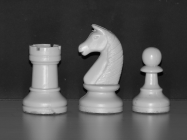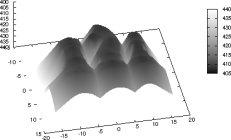
Shape from Shading
Home
About Us
People
Teaching
Research
Publications
Awards
Links
Contact
Internal
Shape from Shading (SfS) means recovering a three-dimensional surface from the shading information contained in exactly one two-dimensional image under known illumination conditions and reflectance properties of the surface.
Classic SfS research, pioneered by Horn in 1970s, had been dealt with images obtained by an orthographic camera model, a light source at infinity and mostly Lambertian surfaces.
However, in recent years modern SfS models have been evolved by employing a perspective camera setting, a point light source at the optical centre of a camera and non-Lambertian reflectance models in an attempt to reflect more realistic scenarios.


These images show a real-world input image, three pieces from a chess set and the reconstruction using one of our most advanced SfS methods.
Research in our group deals with advanced perspective SfS models, which also consider non-Lambertian reflectance functions. Furthermore, our goal includes designing accurate and efficient numerical schemes as well.
-
Direct variational orthographic SfS with non-linear regularisation
In the early years of SfS research, the standard for (orthographic) SfS was to compute the gradient of a surface from shading, and then apply a depth-from-gradient technique. We showed how to avoid this additional step and directly compute the depth using a variational framework. In addition, we introduced non-linear regularisation to this variational framework, which significantly improved the reconstruction quality of orthographic SfS [1].
-
Efficient numerics for perspective SfS
While the first numerical schemes for advanced perspective SfS models have been quite complex, we introduced a novel numerical method for recovering shapes using these models. The algorithm we suggested proved to be significantly easier to implement than other numerical methods and up to ten times faster. [2] [3].
-
Non-Lambertian reflectance models for perspective SfS
Perspective SfS models have usually involved only with Lambertian reflectance, i.e. purely diffuse. In reality, however, most surfaces reflect light specularly as well, which results in highlights. In this respect, we propose a novel model that can handle both the Lambertian reflectance and specular highlights. Experimental results show that this model is one step further towards a realistic scenario, as it improves the reconstruction quality significantly on real-world images. [4] [5] [7] [9].
-
Fast marching methods for advanced perspective SfS models
For orthographic SfS models and early perspective SfS models, it has been suggested to use a fast marching method as a numerical solver. These methods, however, depend on certain points on the surface to be known, and are not compatible with advanced models. We proposed an alternative fast marching method, which is compatible to both the models developed in the recent years and our non-Lambertian model. In addition, this method does not require any depth information or boundary information. Moreover, it shows significant outperformance than other methods. [6] [8] [11].
-
Model analysis for Non-Lambertian perspective SfS
Since non-Lambertian SfS models, in general, non-convex, the efficient fast marching method is not directly applicable. By analysing important structures, e.g. critical points, we investigate the properties of non-Lambertian models from both theoretical and numerical viewpoints. Based on theoretical justification this study gives us useful information, e.g. proper parameter ranges within which the fast marching method can be safely used. [7] [10].
-
O. Vogel, A. Bruhn, J. Weickert, S. Didas:
Direct Shape-from-Shading with Adaptive Higher Order Regularisation.
In F. Sgallari, A. Murli, N. Paragios (Eds.): Scale Space and Variational Methods in Computer Vision. Lecture Notes in Computer Science, Vol. 4485, 871 - 882, Springer, Berlin, 2007.
© Springer-Verlag Berlin Heidelberg 2007. -
O. Vogel, M. Breuß, J. Weickert:
A Direct Numerical Approach to Perspective Shape-from-Shading
In H. Lensch, B. Rosenhahn, H.-P. Seidel, P. Slusallek, J. Weickert (Eds.): Vision, Modeling, and Visualization 2007. Saarbrücken, Germany, 91-100, November 2007. -
M. Breuß, O. Vogel, J. Weickert:
Efficient numerical techniques for perspective shape from shading.
In A. Handlovicova, P. Frolkovic, K. Mikula, D. Sevcovic (Eds.): Algoritmy 2009 (Podbanske, Slovakia, March 2009), pp. 11-20, Slovak University of Technology, Bratislava, 2009. -
O. Vogel, M. Breuß, J. Weickert:
Perspective shape from shading with non-Lambertian reflectance.
In G. Rigoll (Ed.): Pattern Recognition, Lecture Notes in Computer Science, Vol. 5096, 517-526, Springer, Berlin, 2008. -
M. Breuß, O. Vogel, J. Weickert:
Perspective shape from shading for Phong-type non-Lambertian surfaces.
Technical Report No. 216, Faculty of Mathematics and Computer Science, Saarland University, Saarbrücken, Germany, August 2008. -
O. Vogel, M. Breuß, T. Leichtweis, J. Weickert:
Fast shape from shading for Phong-type surfaces.
To appear in Proc. Second International Conference on Scale-Space and Variational Methods (SSVM 2009, Voss, Norway, June 2009). -
M. Breuß, Y. C. Ju:
Shape from shading with specular highlights: Analysis of the Phong model.
In Proc. 18th IEEE International Conference on Image Processing (ICIP 2011, Brussels, Belgium, September 11-14, 2011), 9-12, 2011. -
M. Breuß, E. Cristiani, P. Gwosdek, O. Vogel:
A domain-decomposition-free parallelisation of the fast marching method. -
M. Breuß, E. Cristiani, J.-D. Durou, M. Falcone, O. Vogel:
Perspective shape from shading: Ambiguity analysis and numerical approximations.
SIAM Journal on Imaging Sciences, Vol. 5, No. 1, 311-342, March 2012. -
Y. C. Ju, M. Breuß, A. Bruhn, S. Galliani:
Shape from shading for rough surfaces: Analysis of the Oren-Nayar model.
To appear in Proc. 23rd British Machine Vision Conference (BMVC 2012, Guildford, UK, September 3-7, 2012). -
S. Galliani, M. Breuß, Y. C. Ju:
Fast and robust surface normal integration by a discrete eikonal equation.
To appear in Proc. 23rd British Machine Vision Conference (BMVC 2012, Guildford, UK, September 3-7, 2012).
To appear in Applied Mathematics and Computation.
Revised version of
Technical Report No. 250, Department of Mathematics, Saarland University, Saarbrücken, Germany, October 2009.
MIA Group
©2001-2023
The author is not
responsible for
the content of
external pages.
Imprint -
Data protection